

Click here to be brought directly to particular research areas/projects we work on here at PolyU
Communications - the Future is Now
This is how we connect with each other, live our lives and interact with the world as of Today...
Optical Communications and Networking
The Hong Kong Polytechnic University
Photonics Research Center, The Hong Kong Polytechnic University, Hung Hom, Kowloon, Hong Kong

What we do here at PolyU
At PolyU, we focus on three major areas relating to optical communications and networking research.
Analytical modelling and signal processing techniques for digital coherent communication systems
With the advent of coherent detection and advanced electronic signal processing techniques, cost-effective improvements in fiber-optic communication systems over the next decade will depend increasingly on advanced communication techniques that enhance spectral efficiency and robustness against transmission impairments. In the fiber-optic channel however, the complexity of the interactions between different propagation effects such as chromatic dispersion(CD), Kerr nonlinearity, polarization mode dispersion(PMD) and noise generated by optical amplifiers and laser severely limit the effectiveness and relevance of directly applying well developed signal processing techniques from the wireless or copper-wire literature. We seek to characterize signal propagations in optical fiber from a communication theory point of view. The nature of various system impairments to signal transmission are investigated and appropriate communication and signal processing techniques are developed and shown to significantly improve system performance. These signal processing techniques that is tailored for fiber optic links thus pave the way to practical realization of next generation fiber-optic communications.
Optical Performance Monitoring for future optical networks
The emergence of reconfigurable optical networks offers the potentials for increased flexibility, reduced network operation and maintenance costs, and better exploitation of available transmission capacity by enabling features like automatic path provisioning, fault identification and management, impariment-aware routing and network resources optimization. However, the realization of such potential features demands precise and incessant information about the extent of physical impairments such as optical signal-to-noise ratio (OSNR), chromatic dispersion (CD) and polarization-mode dispersion (PMD) to the transmitted signal and where they originate across the network. Therefore, acquiring real-time knowledge of such physical impairments, or Optical Performance Monitoring (OPM), will be indispensable for the efficient operation and management of such complex dynamic optical networks. As point-to-point communication links is moving towards coherent detection, new OPM techniques specific for coherent systems will be required to further leverage and integrate new transmission strategies in future optical networks.
Next generation optical fibers for long-distance transmission
Ever since the idea of using optical fiber for long-distance information transmission was proposed back in 1966, countless efforts have been made to produce better fibers that reduce signal attenuation or loss during transmission. Transmission fibers having loss coefficients of less than 0.2 dB/km (more than half of the optical power is retained after 15 km of transmission) has been realized over 15 years ago and was already close to theoretical limits. With the advent of technologies such as coherent detection and our ever-increasing bandwidth demand over the past few years , we have totally 'maxed out' the transmission capacities provided by current fibers. Fiber nonlinearity effects and spatial compactness issues seem to be preventing us from going further and prompts researchers to come back and re-think about the transmission medium - the fiber itself. With this objective in mind, we seek to analytically model and derive new fiber designs such as few-mode fibers (FMF) and multi-core fibers that can provide higher bandwidth and spatial compactness compared with conventional fibers. We will map the physics of electromagnetic waves propagation in optical waveguides and communication theories into interesting fiber structures that provide multi-fold improvements in transmission performances. The fiber designs will also be fabricated with our in-house fiber drawing tower and long-distance performance of these next generation fibers will be experimentally characterized.
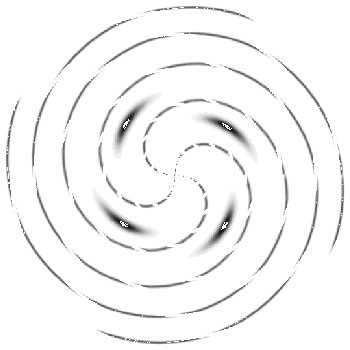
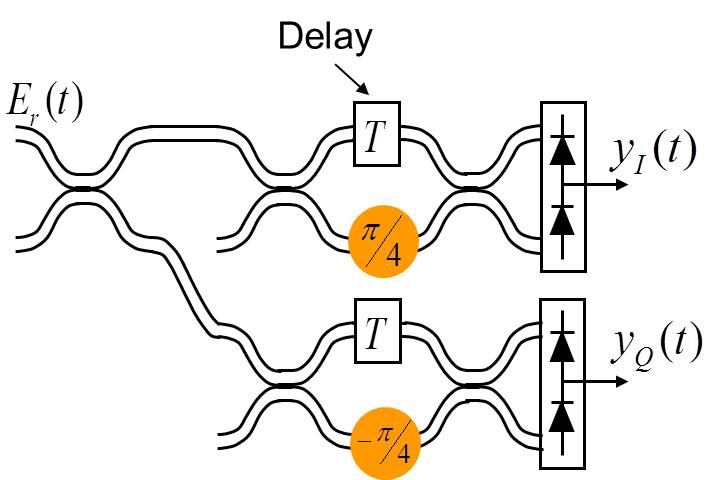
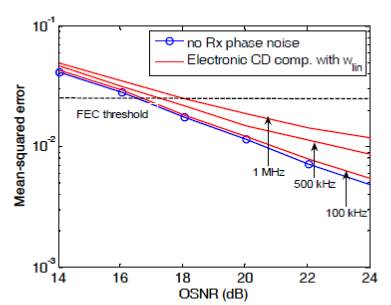
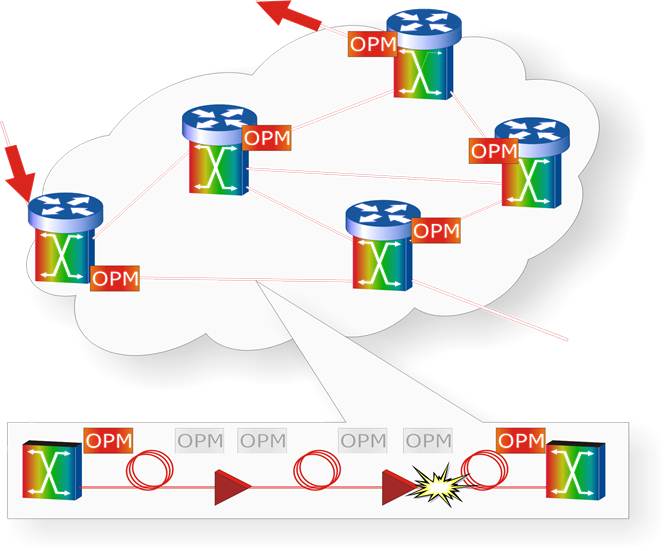
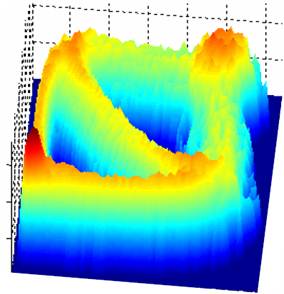
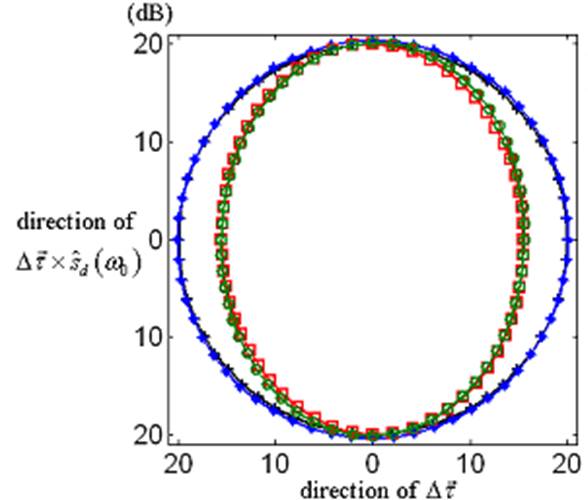
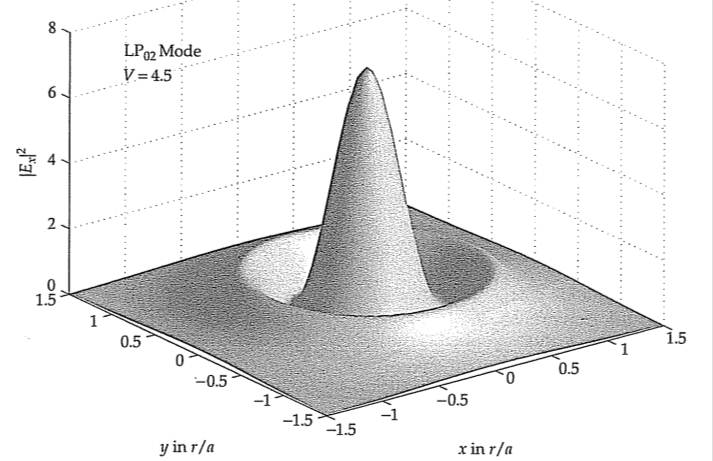
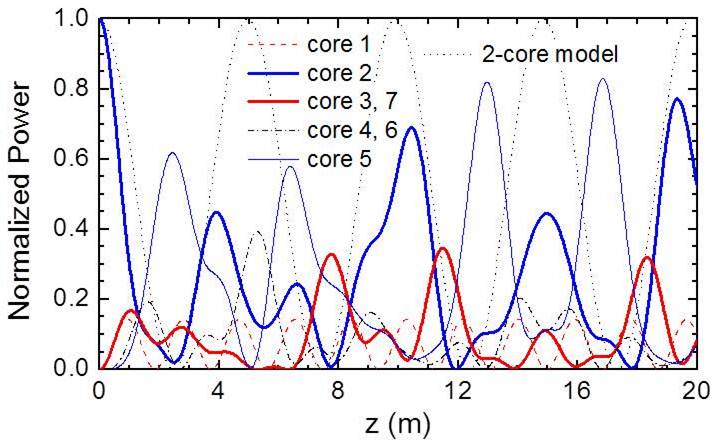
Information is the message/meaning behind. Communication is the FORM at which information is represented and the WAY through which this form of representation is transmitted. In this context, FORM can be words, sound, music, image, video etc. In ancient times, the WAY can be crafting on stones, pigeons, papers. In modern days, the WAY can be AM/FM radio, TV, telephone, pager, cell phone, GPS, Internet etc. The following 2-part video series is a very good summary on how communications evolve over time
Modern Digital Communications and the Internet
In modern age, forms of information such as sound/music and image/video are first converted into an electrical waveform through devices such as microphones and cameras. We call this waveform a signal or an analog or analogue signal in particular. This is in contrast with digital signals that computer use to communicate with each other over the Internet. What are all these about? What are the differences? How do we convert analog signals into digital ones and transmit through the Internet?
Likewise, text and images generated by a computer are represented by numbers which are in turn represented by bits. The way to represent text and images by 1's and 0's (also known as binary digit or bits) must be common to all computers such that they can communicate and understand each other's data without confusion.
Ok. So various forms of information, whether it is text, image, sound or video, are first digitalized and represented by numbers. These numbers are in turn represented by bits (1's and 0's), which in turn are represented by 'on's and 'off's of an electrical signal/waveform. Supplementary information is needed so that the message is successfully transmitted and appropriately processed by another computer. Note that such supplementary information is also encoded by 1's and 0's. EVERYTHING IS DIGITAL.
Now, when we get lots of computers connected together and they represent information and communicate in the same way, or in more laymen terms, talk in the same language, we can build a network. The Internet is born.
Initially when the computers are connected to form the Internet, they are physically connected by copper wires. As technology progress, we are now able to build our Internet on other transmission media, or channels, such as free space (wireless communication) and optical fibers. The way to communicate between different machines, or protocols, are exactly the same. That's how our cell phones and other mobile devices can now fully integrate with any other computers and telephone network.
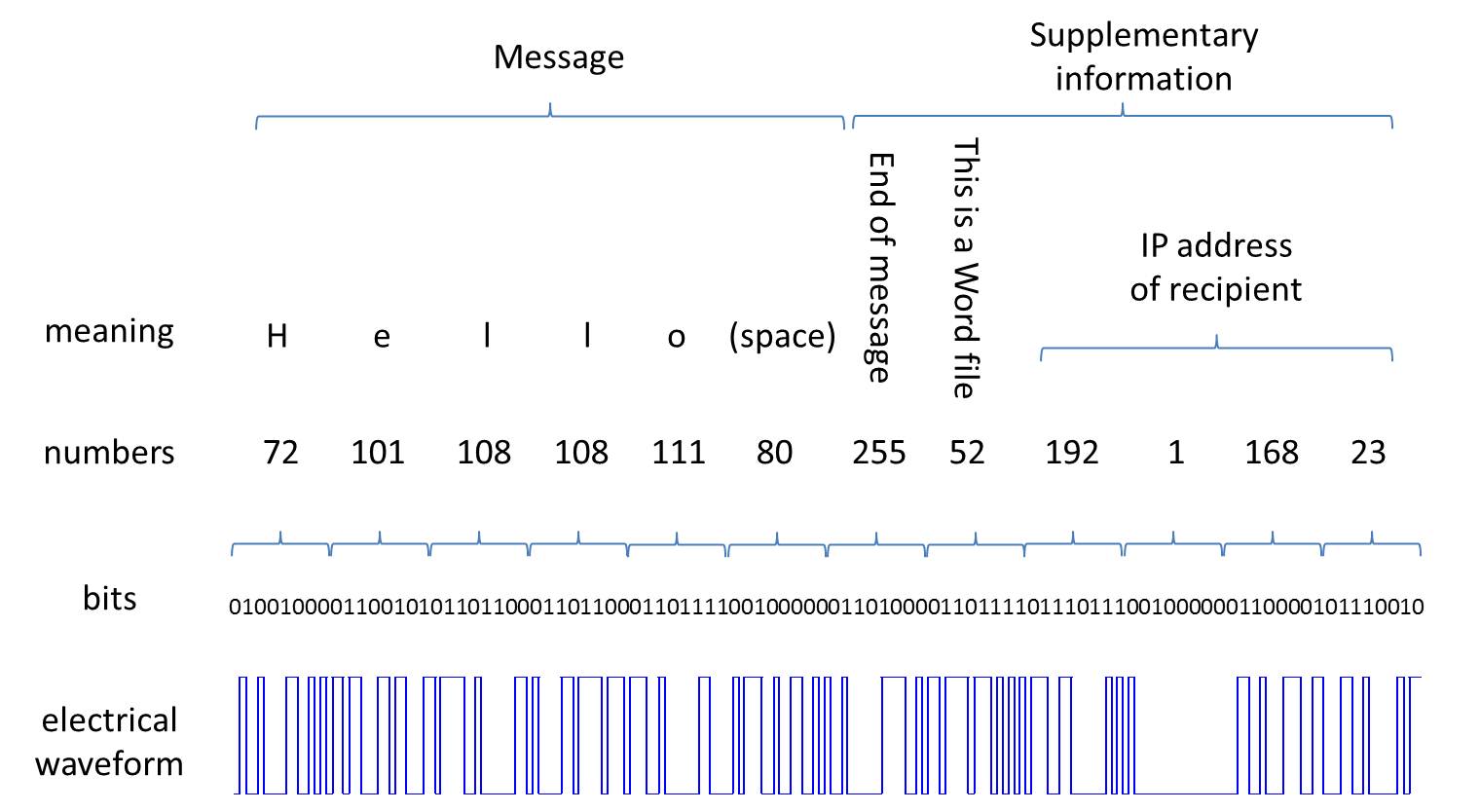
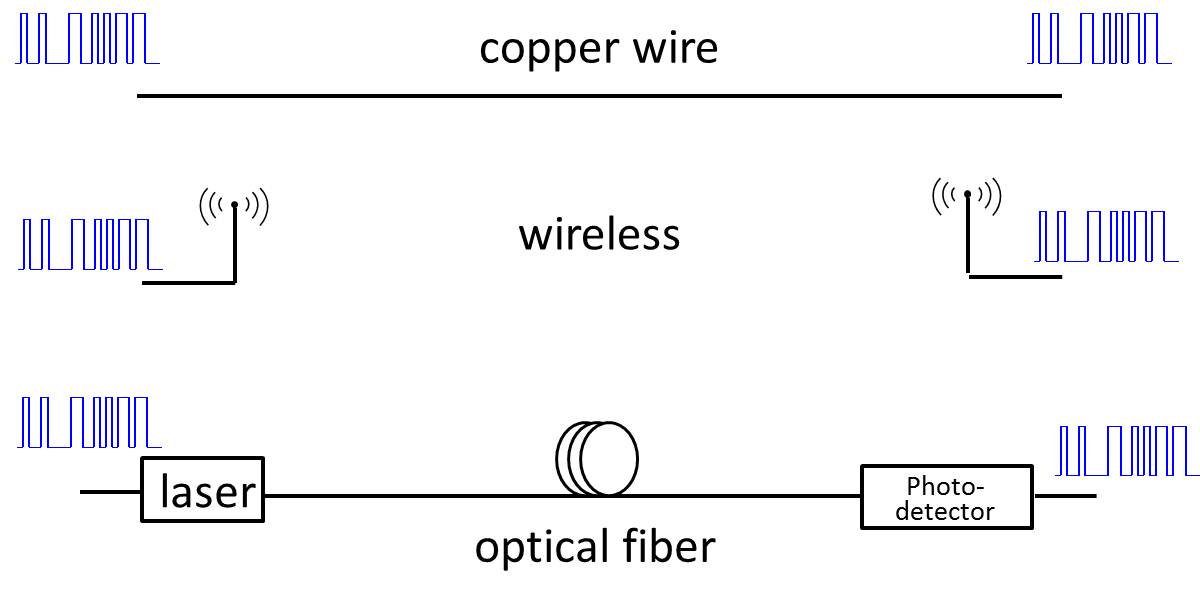
The optical fiber is shown to offer unparalleled bit-rate-distance products. This is what we focus on.
Optical fiber - connecting the world with a tiny strand of glass
An optical fiber consist of two layers of very pure glass called the core and cladding. In the core, extra materials such as Gemanium (Ge) is injected to make its refractive index higher than that of the cladding. Light then travels along the direction of fiber through an effect called total internal reflection. Now, to transmit digital information (1's and 0's), we send a single light pulse to represent '1' and send nothing to represent '0'.
The performance measure - bit rate, bandwidth and transmission distance
How do we describe and compare different communication system? What's the single feature of a communication system that everyone cares about? SPEED. In digital communications, speed is measured in terms of number of bits sent/transmitted per second, or bit/s. When describing large amounts of bits transmitted per second, we will use terminologies such as
1 kbit/s = 1,000 bit/s (one kilobit or one thousand bits per second)
1 Mbit/s = 1,000,000 bit/s (one megabit or one million bits per second)
1 Gbit/s = 1,000,000,000 bit/s (one gigabit or one billion bits per second)
Here are some bit rates required by common applications and bit rates supported by common telecommuication systems.
8 bit/s -> 1 english letter per second
8 kbit/s -> quality of standard land-line telephone signals
192 kbit/s -> the highest quality sound supported by most MP3 encoders when ripping from a Compact Disc (CD)
1411 kbit/s -> standard sound format of CD Digital Audio
384 kbit/s -> video conferencing
3.5 Mbit/s -> Standard-Definition television quality
15 Mbit/s -> High-Definition television (HDTV) quality
29.4 Mbit/s -> HD DVD quality
4.95 Gbit/s -> HDMI
56k Modem -> 56 kbit/s
Fastest copper wire-based broadband -> 160 Mbit/s
GSM (2G wireless system) -> 14.4 kbit/s
GPRS (2.5G wireless system) -> 57.6 kbit/s
CDMA2000 -> 153 kbit/s
UMTS (3G wireless) -> 384 kbit/s
Ethernet -> 10 Mbit/s
Fast Ethernet -> 100 Mbits/s
Gigabit Ethernet -> 1 Gbit/s
Wireless LAN 802.11a -> 54 Mbit/s
Wireless LAN 802.11g -> 120 Mbit/s
Wireless LAN 802.11n -> 600 Mbit/s
Bluetooth 1.0 ->1 Mbit/s
Bluetooth 2.0 ->3 Mbit/s
Bluetooth 3.0 ->24 Mbit/s
Here are some ways to understand these numbers:
Example 1: Wireless 3G (384 kbit/s) can support video conferencing (384 kbit/s) but not a standard TV signal (384
kbit/s < 3.5 Mbit/s
Example 2: Gigabit Ethernet (1Gbit/s) can allow 33 HD DVD movies (33x29.4 Mbit/s < 1 Gbit/s) to be transmitted at
the same time, but not a HDMI signal (1 Gbit/s < 4.95 Gbit/s)
In fact, people working in telecommunications also care about another quantity - transmission distance. As it turns out,its much easier to communication over short distance than to transmit information over thousands of kilometers across the globe. In particular, if the distance is short, the bit rate can be very high. However, when the distance is very long (say, for example, across the Pacific Ocean), the allowable bit rate is very limited. Therefore, the performance metric that the communication industry used is the bit-rate-distance product i.e. bit-rate multiplied by the transmission distance. This bit-rate-distance product continues to increase as technology advances.
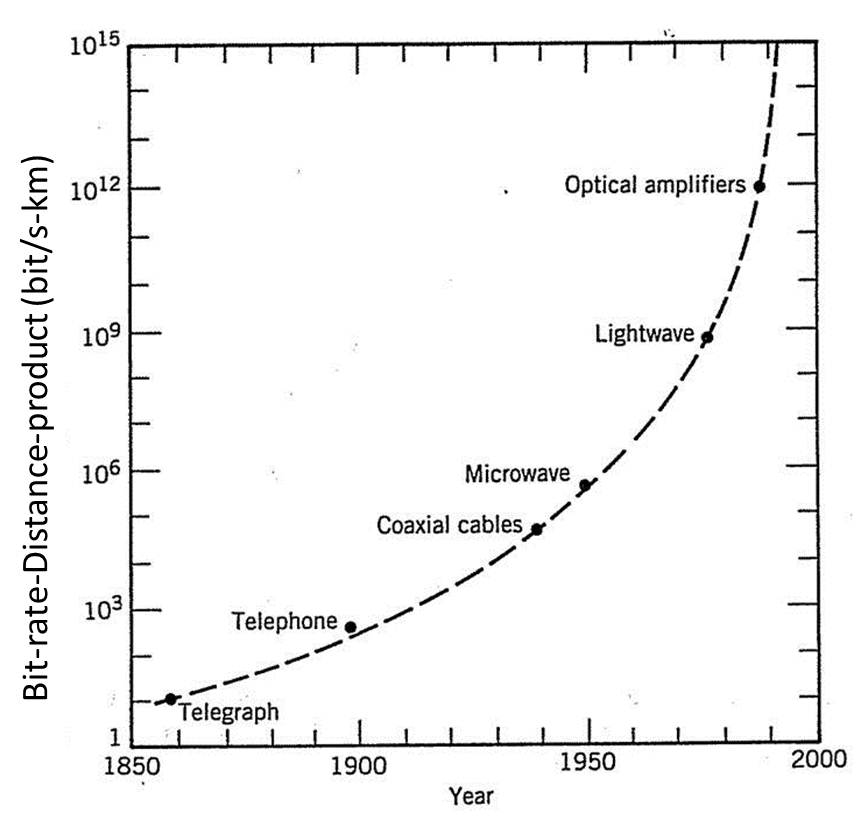
The optical fiber allows computers to talk to each other at tremendous speed over long distances. It is first used in transmitting telephone signals across the Altantic Ocean. As time goes on, more and more computers around the world are connected together and a global optical network slowly emerges. As of today, we already have hundreds of millions of kilometers (> 100,000,000 km) of fiber installed around the globe. The following is a map showing the globe is connected by undersea fiber-optic cables.
- Long-haul networks or wide area networks (WAN): These are networks that connect between cities in a country or cities in different continents across the ocean. The bit rate across these links are really high, up to 40 Gbit/s and even 100Gb/s in 2012.
- Metro networks: These are networks that connects different parts of a metropolitan city. The different points, or nodes, of metro networks are typically called central offices. Internet traffic from/to that part of the city are collected/distributed by that central office.
- Access networks: These are networks that connects individual business, organizations and homes of a particular neighborhood in a city to their corresponding central office. One of the feature of Access networks is that the business/organizations/buildings/homes are connected to a central office but they are not connected with each other. When a home is directly connected to the central office, we call this fiber-to-the-home (FTTH). Likewise, FTTB refers to fiber-to-the-building. Access networks start off using copper wire (a technology called DSL), but these links are slowly replaced by fibers as the per user bandwidth keeps on increasing and copper wire cannot accomodate such a large bandwidth requirement.
- Local Area Networks (LAN): This is probably the most well-known. Basically, these are the networks that connect different computers within an organization. Sometimes we also call this intranet. Most LANs are still copper wire based since there is typically no need for such a fast connection for an individual user inside a LAN.
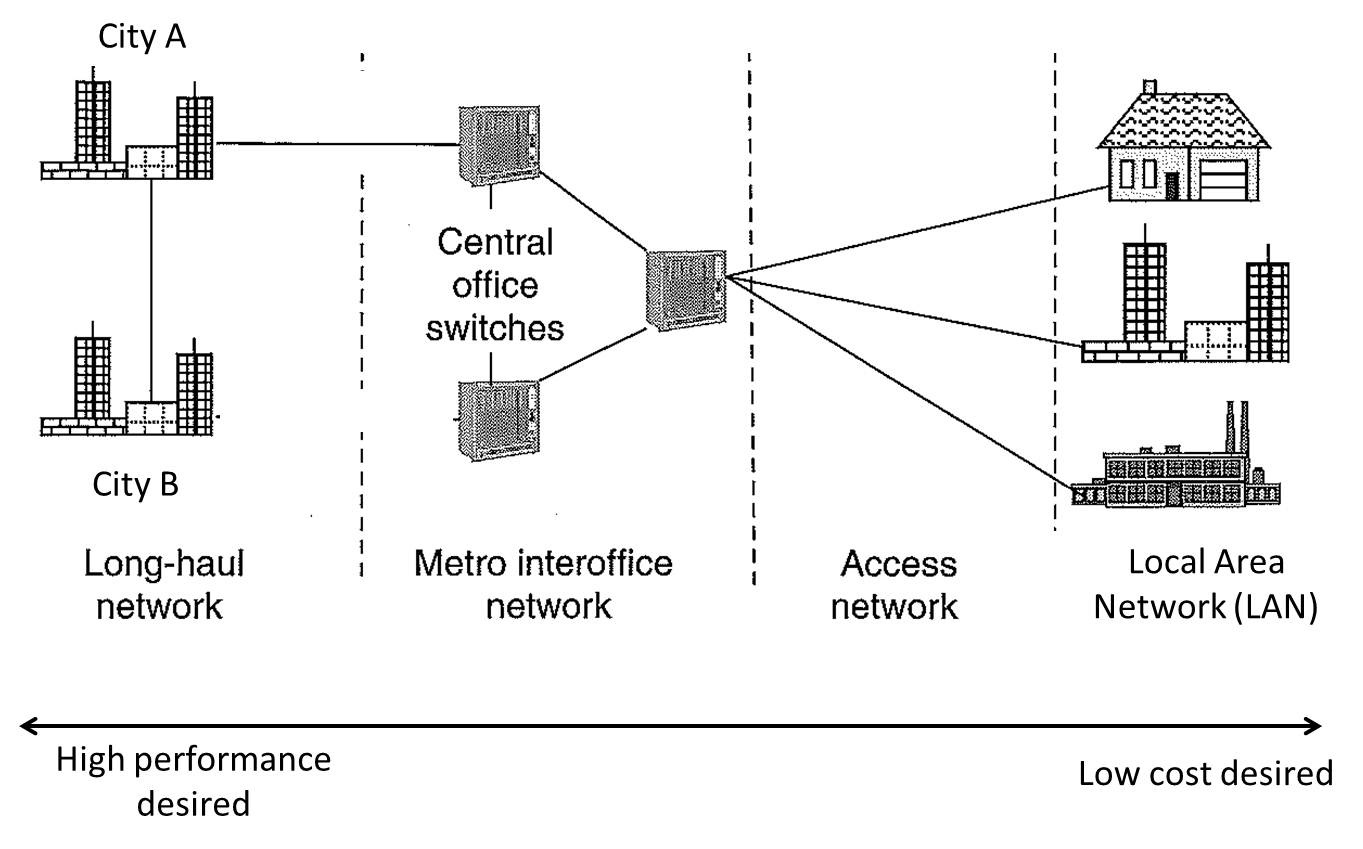
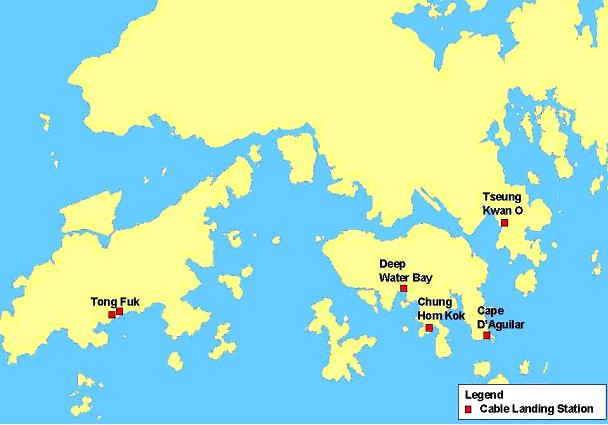
How do we put these submarine cables under the sea? As it turns out, laying down these cables are by itself a daunting task and require a lot more expertise and efforts than one would think.
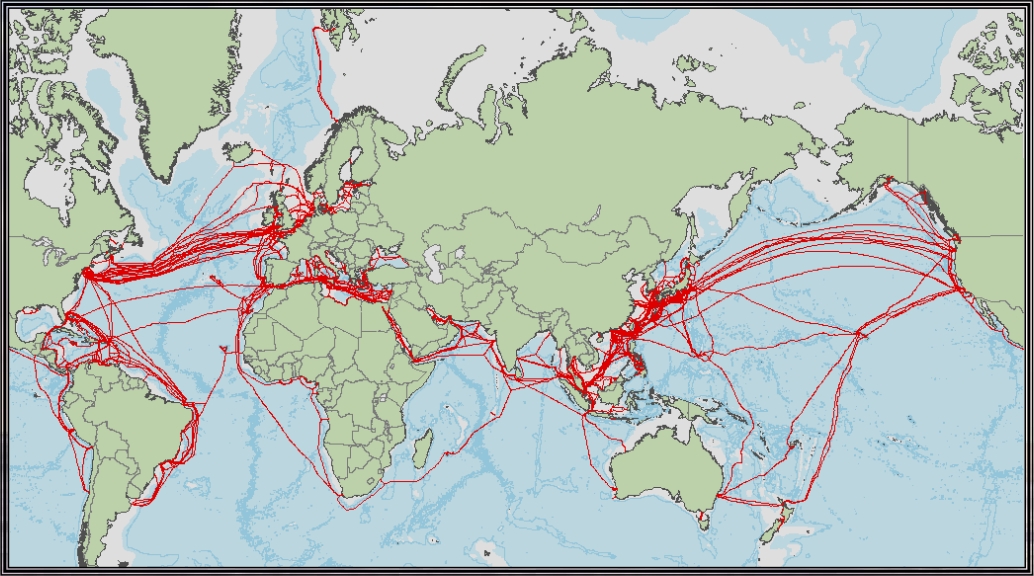
In Hong Kong, there are 6 'landing sites' for the fiber-optic cables which connects us to the rest of the world.
From everywhere on Earth to your desk - different layers of communication networks
Optical fibers does not only exist in submarine undersea cables as there are different types of communication networks. There are networks that connect different cities in a country. There are networks that connects different parts of a metropolitan city. There are networks that everyone within several blocks of street connected. Finally, there are the well-known local-area-networks (LAN) that connects people in a same company or different computers in your home together. The networks are categorized into different types because some of them really needs high speed transmission, some of them needs to be low-cost and others need to make sure only certain people can use the networks.
Typically, networks on a larger scale (submarine networks) needs higher speed rate and doesn't care about the cost that much. On the contrary, for access netowrks or LAN, as each individual user does not need lightning fast connection and cost is a major concern instead (think about it: do you really need your computer at home to be able to download a 20-min YouTube clip in 1 second ? Would you pay $3000 /month for such service?). This will answer the commonly asked question "I've heard about fiber-optics for a long time, but why haven't I seen one at home or used one?" That being said, bandwidth demand from each indiviual has been constantly increasing to a point that fiber-to-the-home (FTTH), or optical access network, is becoming more common.
Shaping the way we live - Social impacts of optical fiber communication and the Internet
There is no doubt that optical fibers and other communication technologies has revolutionized the way we communicate and shape the way we live. The tremoudous speed provided by optical fibers enable a lot of social activities like buying things, talking to people and getting information much more efficiently over the Internet. This in turn is exactly how our way of living evolves with communication technologies. This flow process is illustrated below.
To really measure the impact of optical communications in our lives, some Internet statistics and future use of Internet are shown below. The numbers are shocking and reflects how we are truly dependent on communication technologies.
Social Media
Perhaps the most apparent change in the way we live and communicate is the dominance of social media like Facebook. We post, talk, and look at pages from other people and that is becoming a primary source of information and surpassing others as the most common platform where people connect with each other.
The Future of Communications
The Internet has developed from a source of information to a platform where we create and share information. We evolve from a information acquirer to information provider to our friends and everyone else on Earth. With faster and faster connections, we will be even more dependent on Internet. More and more things (other than computers) will be connected to the Internet to form the so called 'Internet of Things'. What will we go from here? Where will communication technologies take us? No one knows for sure.
Negative Impacts of Communication Technologies
Communication technologies allow everyone to connect to everyone easier than ever before and certainly bring us closer together. But is that really true? Increasely, we have witnessed that as people talk more on the Internet, they talk less in real life. It is now typical that a family living together may not talk to each other over a certain amount of time simply because they are all separately connected to the Internet and doing their own things. Are the things that appear to bring us together actually pulling us apart?
In addition to changing how people interact with each other, the Internet knows increasingly more about us and have more control over us. What if our dependence on the Net is being exploited for spurious purposes?
We research and enable better means to communicate, but its up to all of us to make use of the technology for the true benefit of everyone.
Futuristic? Already taken for granted? How did we come to all this?
Fiber-optic Communications - Introduction
We all have heard about fiber-optic communications and how it transforms and shapes the way we live. What is it and how does it work?
Information and History of Communications
Lets even go a step backward and ask: what is communication and how do we communicate with each other? To communicate is to tell people something, or to convey information to someone. Wait.... what is information?
